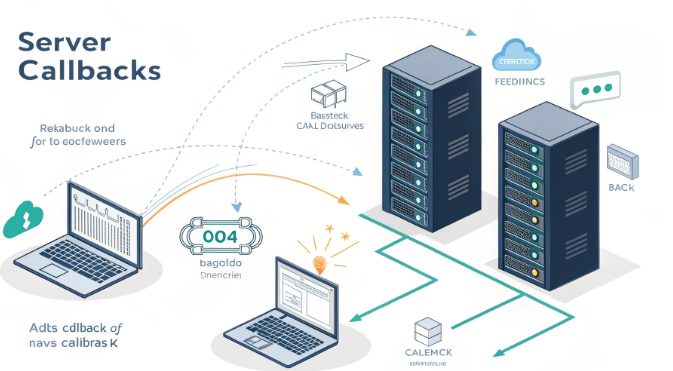Server Callback Mechanisms: A Dive into Modern Architecture

In the evolving landscape of server architecture and Hong Kong hosting environments, callback mechanisms have become fundamental building blocks for modern applications. These asynchronous communication patterns enable servers to handle complex operations efficiently while maintaining optimal performance. Whether you’re dealing with webhook implementations or designing scalable hosting solutions, understanding callback mechanisms is crucial for modern developers.
Understanding Server Callbacks: Core Concepts
At its core, a server callback mechanism is an architectural pattern where a server delegates processing to another service or component and receives a response when the processing is complete. This pattern is particularly relevant in distributed systems and microservices architectures.
- Asynchronous Operations: Callbacks enable non-blocking execution
- Event-Driven Architecture: Facilitates reactive programming patterns
- Distributed Processing: Enables load distribution across multiple servers
The Architecture Behind Server Callbacks
Server callbacks operate on a fundamental principle of “don’t call us, we’ll call you.” This architectural approach brings several advantages to modern hosting environments:
- Decoupled Systems: Services can operate independently
- Improved Scalability: Better resource utilization across servers
- Enhanced Reliability: Robust error handling and retry mechanisms
- Efficient Processing: Optimized task execution and resource management
Implementation Patterns and Best Practices
When implementing server callbacks in modern hosting environments, several patterns have emerged as industry standards. These patterns ensure robust and maintainable callback implementations:
- Idempotency Keys: Ensuring duplicate callbacks don’t trigger multiple actions
- Retry Mechanisms: Implementing exponential backoff strategies
- Timeout Handling: Managing callback timeouts effectively
- Authentication: Securing callback endpoints
Security Considerations in Callback Systems
Security remains paramount in server callback implementations, especially in enterprise hosting environments. Here are critical security measures to consider:
- HMAC Validation: Verifying callback authenticity through cryptographic signatures
- Rate Limiting: Protecting against callback flooding
- IP Whitelisting: Restricting callback sources
- Payload Encryption: Securing sensitive data in transit
Common Use Cases in Modern Architecture
Server callbacks find applications across various domains in modern hosting architectures:
- Payment Processing: Handling asynchronous payment confirmations
- Data Synchronization: Maintaining consistency across distributed systems
- Workflow Automation: Managing complex business processes
- Service Integration: Connecting disparate systems efficiently
Performance Optimization Techniques
Optimizing callback performance is crucial for maintaining efficient server operations. Consider these key strategies:
- Queue Management: Implementing proper message queuing systems
- Load Balancing: Distributing callback processing across servers
- Caching Mechanisms: Reducing redundant processing
- Connection Pooling: Optimizing resource utilization
Monitoring and Debugging Callback Systems
Effective monitoring and debugging are essential for maintaining reliable callback systems in hosting environments. Implement these crucial monitoring strategies:
- Real-time Logging: Tracking callback execution and failures
- Metrics Collection: Measuring callback performance and latency
- Alert Systems: Notifying teams of critical issues
- Debugging Tools: Implementing comprehensive tracing mechanisms
Future Trends in Server Callback Architecture
The evolution of server callback mechanisms continues to shape modern hosting architectures. Emerging trends include:
- Serverless Callbacks: Integration with FaaS platforms
- AI-Enhanced Routing: Smart callback distribution systems
- Edge Computing Integration: Distributed callback processing
- Real-time Analytics: Advanced monitoring capabilities
Best Practices for Implementation
When implementing callback mechanisms in your hosting infrastructure, consider these essential practices:
- Version Your Callbacks: Maintain backward compatibility
- Document Everything: Provide comprehensive API documentation
- Test Thoroughly: Implement extensive testing scenarios
- Plan for Scale: Design with growth in mind
Conclusion
Server callback mechanisms remain a cornerstone of modern hosting architectures, enabling efficient, scalable, and reliable communication between distributed systems. By implementing robust callback patterns and following security best practices, organizations can build resilient systems that handle complex operations effectively. Whether you’re managing colocation facilities or implementing webhook systems, understanding and properly implementing callback mechanisms is crucial for success in today’s distributed computing landscape.
For developers and system architects working with hosting environments, mastering callback mechanisms is essential for building scalable and maintainable systems. As technology continues to evolve, callback patterns will remain fundamental to modern server architecture, enabling the next generation of distributed applications and services.

